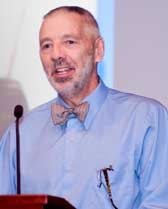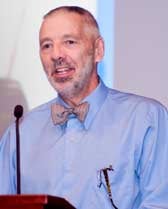 KINGSTON, R.I., Feb. 16, 2015 – Chemistry and fashion might seem like an odd pairing, but in the life of University of Rhode Island professor Martin Bide the two fields are as entwined as the yarns of a hooked rug.
KINGSTON, R.I., Feb. 16, 2015 – Chemistry and fashion might seem like an odd pairing, but in the life of University of Rhode Island professor Martin Bide the two fields are as entwined as the yarns of a hooked rug.
As a professor in the Department of Textiles, Fashion Merchandising and Design, Bide studies the science of color and textiles, focusing on fibers, dyeing, printing and the environmental impact of making textiles.
The Hopkinton resident – and native of the United Kingdom – has won a slew of honors and awards, and the latest is a gold medal from the Society of Dyers and Colourists, an England-based educational charity dedicated to advancing the science and technology of color worldwide. The medal cites Bide for “support of education in coloration.”
URI’s Marketing and Communications Office talked with Bide about the award and some of the color-related projects he has worked on over the years.
Congratulations on your award. The Society of Dyers and Colourists sounds impressive – and a bit mysterious. What does the group do?
They started out in the late 1800s as a professional association for dyers in the UK. Now they deal with color more generally, and globally. They have a strong educational mission, and the medal recognizes my long experience in teaching about color.
How did you get started in color? Isn’t your background in organic chemistry?
I did a major in “Colour Chemistry,” which dealt with fibers and dyes, so the link between the (organic) chemistry of dyes and the color produced when they are applied to fibers was there from the beginning.
What is so fascinating about color?
If you don’t think about it, color is fairly straightforward, but it gets complicated as soon as you begin to examine it in detail. The color you see changes with the light shining on it, but your brain is wired to ignore that. So it appears that the color of your clothes indoors and outdoors is the same, but if you were to see them side-by-side, they would look quite different. And two colors that match perfectly in one light can look drastically different in another light. So designers and dyers have to be really careful to avoid expensive mistakes.
Who do you teach color to?
Early in my career at URI I developed a course in “Color Science.” It is useful to textile and fashion majors, but students can take it as a science elective and it attracts majors from all over campus. It deals with a whole range of color-related topics, including why grass is green. (While most people would know that it is green because it contains chlorophyll, the real question is why chlorophyll should reflect green light, and not absorb it!).
I also cover color-based topics in other courses I teach: Textile Science, and Dyeing and Finishing.
What other colorful things have you done?
I have been president of the American Association of Textile Chemists and Colorists. In my work on pollution prevention in the dyeing industry, I have visited textile operations in many countries: India, Ecuador and Tunisia, for example. And with my colleague, Margaret Ordonez, I developed a database of dyed fibers for the FBI. The history of color application is also fascinating, and as part of Rhode Island’s quilt documentation project, I did some research that involved interpreting old Rhode Island dyers’ and printers’ notebooks: one recipe started with 15 dozen eggs!
Is it all color? What else have you worked on?
Dyeing and color can lead to spin-offs in some less-than-obvious directions. I used the theories of dye-fiber interactions to help develop medical textiles that have been the subject of several patents. With BioSurfaces of Ashland, Mass., we developed artificial arteries that resist infection and the tendency to form clots, and that are more compatible with the body. And we developed other products that promote clotting, which led to a high-tech wound dressing.
Whose clothes do you like to wear? Any preferences?
I like wool. I’m still a big fan of Marks and Spencer in the UK, and I’m happy to wear recycled clothes!
Pictured above: Martin Bide, a professor of Textiles, Fashion Merchandising and Design at the University of Rhode Island. Photo by Michael Salerno Photography.

